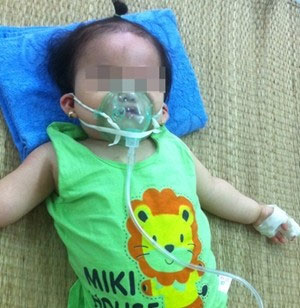Pneumonia in young children - Dangerous but difficult to identify
Many parents are subjective when they see a little cough, no fever, eat normally and buy antibiotic treatment. However, many babies after 1 day have progressed to pneumonia.
>>>Vegetables are good for pneumonia
Mr. Nguyen Bao Anh (34 days old, Ha Nam) went to the Central Children's Hospital when there were manifestations such as coughing, swollen nose, shortness of breath, abdominal distress… The family took her to the private clinic for examination. Indications for use of cough and digestive enzymes. Two days later, I saw that my child did not support me poorly, quickly, tiredly, and cried a lot, my family took me to the National Children Hospital. Here, after the examination and shooting inspection film, the doctors concluded that he had severe pneumonia, showing signs of respiratory failure.
Another case is Bao Long (10 months old, Hanoi). He was taken to the hospital by his family when he saw signs of respiratory infections such as coughing, runny nose, mild breathing, no fever. and eat normally. At first, thinking that children are sick from changing weather like every time, families buy antibiotics for home treatment. However, just over a day later, the disease progressed rapidly, the family took the child to hospital, the child had severe respiratory failure, pneumonia.

One case of pneumonia patients must breathe oxygen in Respiratory Department - (Photo: BV provided)
According to Dr. B. Le Hong Hanh, deputy head of Respiratory Department, National Hospital of Pediatrics, the situation of parents not able to detect pneumonia early makes children hospitalized when the disease is too severe is quite common. In the Respiratory Department, the number of children hospitalized with pneumonia always accounts for a high proportion, mostly children under 5 years old.
Pneumonia (also called bronchopulmonary inflammation in young children) is an inflammation of the small bronchioles, alveoli and alveolar organizations. In Vietnam, children with bronchopulmonary inflammation account for 30-34% of cases of medical examination and treatment in hospitals. Death from pneumonia accounts for 75% of respiratory diseases.
The cause of this disease is due to respiratory syncytial virus, influenza virus, flu and adenovirus, accounting for 60-70% of common cases. In addition, the disease is caused by pneumococci, streptococcus, haemophilus, staphylococci and atypical bacteria. The disease usually occurs in children under 1 year of age, premature birth, underweight, malnutrition, rickets, chronic respiratory disease, living in polluted environments.
Symptoms include: fever, hypothermia (newborn), fatigue, poor appetite, dry lips, dirty tongue, bad breath, cough (dryness or phlegm), difficulty breathing. Fast breathing compared to age is considered the main sign and appears earliest when children have pneumonia.
In addition, Hanh said, parents can monitor more for children when they see signs of shrinking chest, nasal flaring wings . should be taken to the hospital for examination and timely treatment.
Children with pneumonia are easy to relapse, so preventive measures are often emphasized by Dr. Hanh. Pregnant mothers need to eat enough food, periodical pregnancy checkup, full vaccination; clean the children's living environment; early and prolonged feeding. In particular, it is necessary to detect signs of respiratory infections in general and pneumonia in particular to receive timely treatment.
- Instruct mothers to identify children with pneumonia with their eyes at home
- Simple way to prevent pneumonia for children during the season
- Early signs of pneumonia in children during the cold season
- Pneumonia: Causes, symptoms and treatment
- Otitis media can cause dangerous hearing loss in children
- Fitness methods for young children: New, unique or dangerous?
- Pneumococcal pneumonia - Dangerous disease in children
- How hot is the season, how is the disease prevention for children?
- How to identify children with dengue fever
- How to prevent bronchitis in children
- Hib is no less dangerous than HIV
- Vegetables are good for pneumonia
 Green tea cleans teeth better than mouthwash?
Green tea cleans teeth better than mouthwash? Death kiss: This is why you should not let anyone kiss your baby's lips
Death kiss: This is why you should not let anyone kiss your baby's lips What is salmonellosis?
What is salmonellosis? Caution should be exercised when using aloe vera through eating and drinking
Caution should be exercised when using aloe vera through eating and drinking